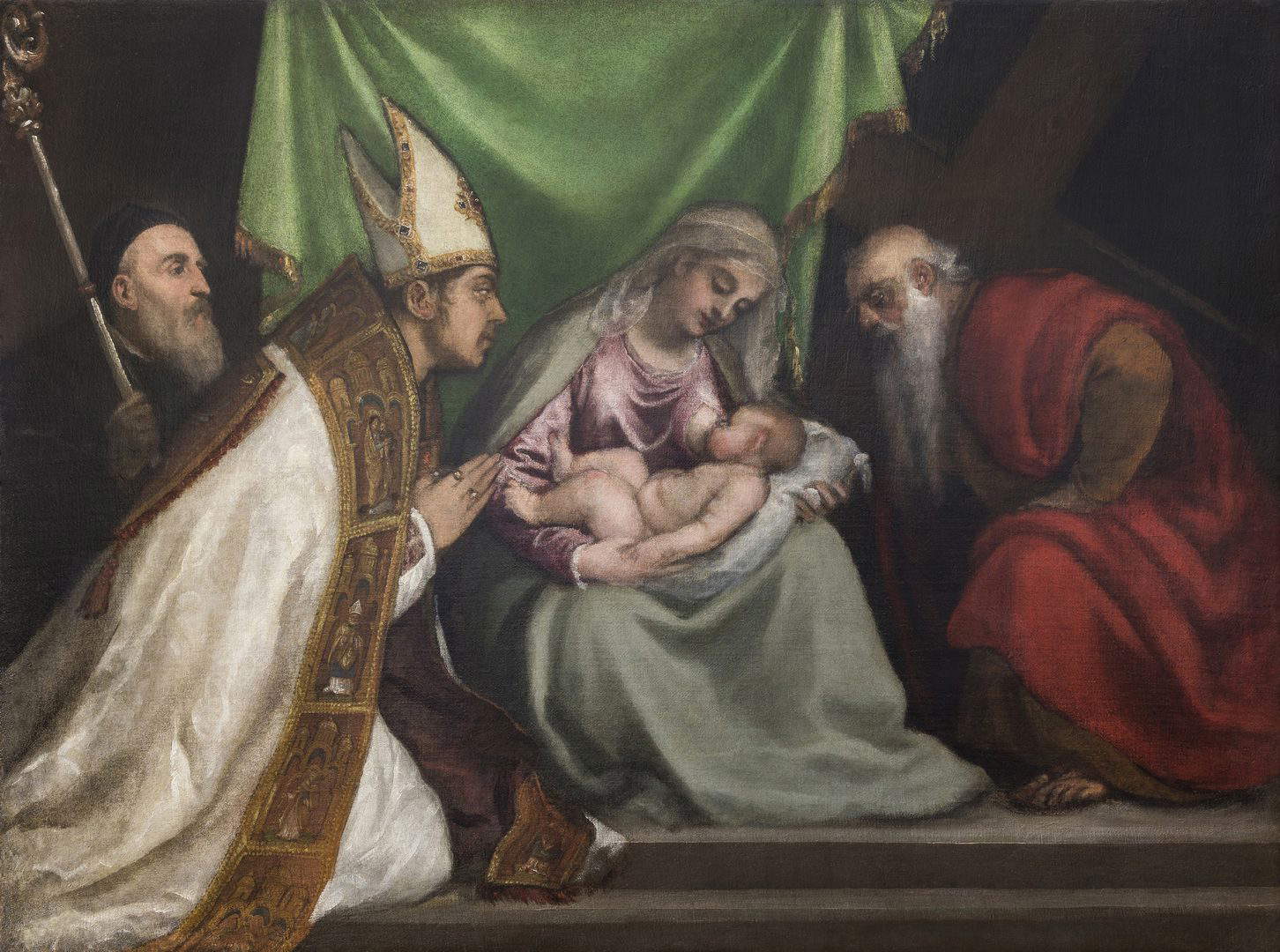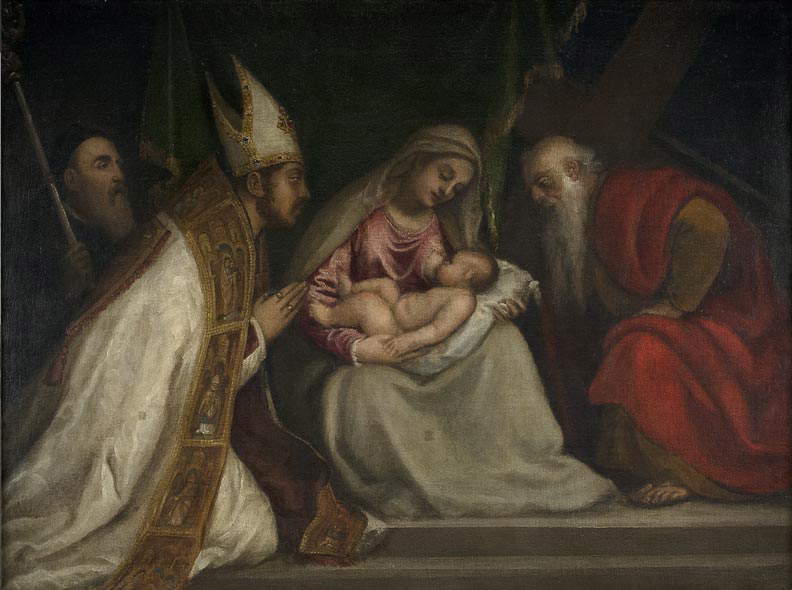In Pieve di Cadore (Belluno), the restoration of the Madonna and Child between Saints Titian and Andrew by Titian Vecellio (Pieve di Cadore, c. 1490-Venice, 1576) preserved in the Archdeacon’s Church in the great artist’s hometown has been completed. The intervention was desired by the Titian and Cadore Study Center Foundation for its 20th anniversary and proved invaluable in revealing the original colors of the work and in getting confirmation of theautography of the master, who created the work without the involvement of his workshop, according to the results. The intervention, diagnostic and archival investigations will make it possible to reconstruct the genesis and events of the last 5 centuries, including the attempted or partially successful thefts that this work has suffered.
The masterpiece of strong private value (in fact, it includes the painter’s self-portrait in the faithful on the left holding the pastoral staff of his namesake saint, titular of the family chapel, and the face of his brother Francis who died in 1560, and was donated by Titian to his hometown) has also been restored thanks to the Galvalux company and now enjoys a new setting and a new lighting system made and donated by Linea Light Group.
The outcomes have been described as “important and exciting.” The intervention, carried out by Francesca Faleschini and accompanied by diagnostic analysis on the work, has in fact revealed not only the quality of the painting and the colors found, but also, as anticipated, the full autography of Titian, where it was believed that the canvas was instead the result of collaboration with the workshop or aids. This is a significant result for the author’s biography, considering also the value of the small altarpiece made for the Vecellio chapel in the church dedicated to Mary, here sweetly depicted in the act of suckling Jesus, and donated by Titian to the city.
Already in the Pastoral Visit of 1604 the painting, mentioned by Vasari in the 1568 edition of Lives (the ante quem date for its dating), was described as “beautiful” and by the hand of Titian. Conservation interventions, carried out at some of the Foundation’s rooms in Pieve di Cadore, equipped for the purpose, have made it possible to show the public the concealed chromatic tones and totell the story of the “scars” that this painting bears, such as the marks of the cuts made in the attempted 18th-century theft (prior to 1729) that circumscribe the figure of the Madonna and Child.
The study of the constituent material has unveiled and clarified some questions and will help to better define in the coming months the curious vicissitudes suffered by the painting during these last five centuries (including restorations and havocs, such as the theft suffered by the work in modern times) also making use of the physical and chemical diagnostic analyses carried out and the analytical study of historical and archival sources. Also because the restoration was an opportunity to combine skills, knowledge from multiple professionals, through constant comparisons between art historians, scientific technicians, photographers, researchers and scholars.
All information and considerations that will flow into the volume that the Foundation will publish in the fall, edited by Stefania Mason Chair of its Scientific Committee, with essays by Don Paolo Barbisan, Elisa Buonaiuti, Davide Bussolari, Alessandra Cusinato, Enrico Maria Dal Pozzolo, Francesca Faleschini, and Nicole de Manincor.


As of now, it can be said that radiography, reflectography and stratigraphic microsamples have in every way validated the preparatory drawing, the execution technique, the pigments used by Titian and the subsequent interventions. And just by comparing the technique of this painting with some examples of recently analyzed and restored works, such as the Annunziata in Treviso and the Assunta dei Frari, it was possible to confirm “the objectivity of Titian’s executing hand,” the Titian Study Center explains.
The superficial aesthetic state of conservation did not allow the objective reading of the actual colors because they were concealed by the various layers of oxidized varnish and by pictorial backgrounds pertinent to later interventions. An example is the green drapery behind the scene: seven overlapping layers were detected. The most superficial ones, glazes and brushstrokes used in an attempt to revive the brightness of the painting, were found to be altered and blackened. Removal of the altered layers thus brought back the folds and brightness to the drapery.
The timely observation of the constituent materials and execution technique used by Titian allowed us to understand once again the great knowledge and flair of this master of painting, but also the various regrets/rethoughts during execution, as in the case of the self-portrait.
In the X-ray, the change in the position of the face, initially placed three-quarters, toward the viewer, and then reshaped with the gaze turned to the central scene of the Infant Madonna, is clearly evident.
“It is a source of great satisfaction for all the members of the Titian and Cadore Study Center Foundation,” says President Giovanna Maria Coletti, “to celebrate these first intense 20 years of activity, with a permanent enrichment intervention, for the knowledge of the art of the great Cadore artist, thanks also to private partners, enhancing a work by Titian that testifies to the artist’s deep connection with his lands and that will be unmissable for those who love the Venetian Renaissance and want to know the Master in his most intimate context. Of course, all this would not have been possible without the full collaboration of the Soprintendenza Archeologia, Belle Arti e Paesaggio for the metropolitan area of Venice and the provinces of Βelluno, Padua and Treviso and the Archdeaconry of Cadore, with Monsignor Diego Soravia.”
 |
| Restoration of Titian's altarpiece made for his Pieve di Cadore completed. |
Warning: the translation into English of the original Italian article was created using automatic tools. We undertake to review all articles, but we do not guarantee the total absence of inaccuracies in the translation due to the program. You can find the original by clicking on the ITA button. If you find any mistake,please contact us.